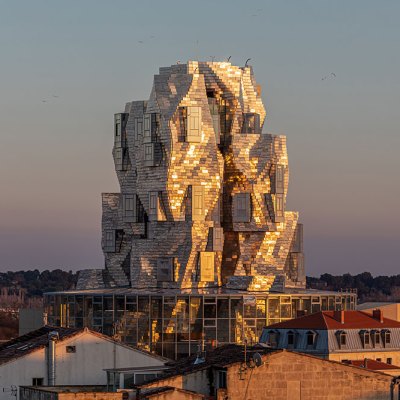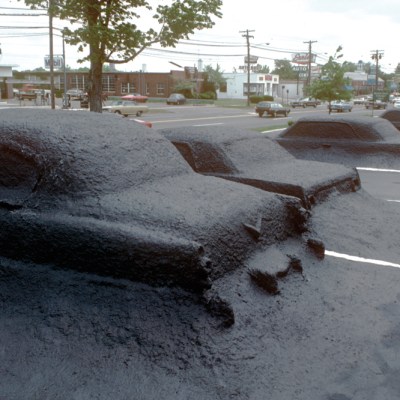From the September 2023 issue of Apollo. Preview and subscribe here.
There was a time when architects wanted to be intellectuals. Bored of the banalities of late modernism, struggling to build in an unsympathetic environment and seduced by French theory, they forged an angular, almost punkish and often impenetrable new architecture. What is now known as ‘deconstructivism’ became the style of the late 1980s and early ’90s – although none of its practitioners would have been flattered by their efforts being seen as a mere style.
Quite how stylish deconstructivism could be became clear in Bernard Tschumi’s designs for the Parc de la Villette in Paris, one of the earliest and most influential monuments of the movement – if we can call it a movement. Inspired by the writings of Jacques Derrida, this was an architecture about fragmentation and deconstruction – literally so, as the elements were broken down into pieces and distributed across the park. Tschumi was always more interested in film than traditional ideas about architecture, in creating a storyboard, in editing and distributing. The Swiss architect’s lipstick-red follies appear as fragments of a constructivist fantasia, unrealised pieces of a dream of a revolutionary moment. Thirty years after Tschumi won the international competition, the Parc de la Villette embodies all the contradictions and the seductions of decon.
If Tschumi’s slick and graphic cut-ups represent one end of decon, at its other end is Frank Gehry’s Santa Monica house of 1978. A trash-can assemblage of builder’s yard materials and wacky angles, the haunted extension arrived in a nice neighbourhood that upended notions of propriety and gravity. At the time it looked like a strange future – an avant garde built from the scraps of backlots – and one that appeared to be breaking down.
Other architects produced work somewhere between these extremes. An alien-looking rooftop office by Coop Himmelb(l)au in Vienna or the sinister, parasitic designs of Lebbeus Woods, for example, looked to sci-fi. Rem Koolhaas, co-founder of OMA, developed surreal structures which, arguably, changed architecture forever. His one-time colleague Zaha Hadid built her career on early designs evoking the fragmented paintings of Kazimir Malevich and El Lissitzky.
It was the critic Joseph Giovannini who coined the term ‘deconstructivism’ in 1987, intending it as a portmanteau of deconstruction and constructivism, the two major impulses behind the new architecture. The collision of literary ideas, art practice and the avant-garde graphics of the Soviet revolutionary era was explosive. Architects attempted to shoehorn the extreme utility of architecture – of buildings that had to be engineered to stand up and withstand the weather – with the convolutions of French philosophy and linguistics and the paradoxical implications of the collapse of meaning for built form.
It was MoMA that brought the new style into the museum a year later. ‘Deconstructivist Architecture’ was curated by Philip Johnson and Mark Wigley and presented its subject as an alternative to postmodernist architecture, which was becoming increasingly classical and increasingly kitsch. (As the poseur-provocateur who had championed modernism in the United States in the 1930s, Johnson was once again keen to associate himself with what looked, then, like the future.)
If postmodernism tried to reconcile high and low culture, then decon was an attempt to reestablish architecture as a highbrow pursuit and to stir things up. It also signalled the end of international modernism as a utopian project, its visual distortion acknowledging the destruction of the post-war consensus and a new age of economic extremes.
Frank Gehry’s house in Santa Monica (1987). Photo: BDP/Alamy Stock Photo

The origins of deconstructivism were obscured in the MoMA show, but there are clear precedents in post-war German architecture (notably the dynamic work of Hans Scharoun and Günther Behnisch) and in the United States with the knowing oeuvre of James Wines and SITE, with its part-ruined department stores for the BEST chain (see February 2020 issue of Apollo). The ghost of the artist Gordon Matta-Clark, who made a career out of cutting holes in buildings and slicing through architecture, also haunts decon.
The proponents of decon, however, remained deadly serious, often about buildings which determinedly failed to work. This is particularly true of Peter Eisenman, who deliberately designed houses with fissures and partitions that made life more, rather than less, difficult. He also designed bedrooms in which it was impossible to place a double bed, floors with holes and columns placed to make spaces virtually uninhabitable. He did not live in a house of his own design.
Unlike Soviet constructivism, which aimed to design a whole new aesthetic world, deconstructivism was less concerned with politics and this deliberately difficult style was quickly co-opted by commerce. By the early 1990s there were nightclubs with dramatically exploded structures and collapsing storefronts, restaurants such as Kate Mantilini in Santa Monica and visual gags in the form of the Fred and Ginger Building designed by Frank Gehry in Prague, in which two towers appear to dance. Some moments exerted a lasting influence, none more so than the jagged, dark nightmare of Daniel Libeskind’s Jewish Museum in Berlin.
Unlike other isms, deconstructionism has stuck around. Its ghost flits around the pix – elated facades of new skyscrapers by BIG and Ole Scheeren. It is there in the awful renderings of NEOM in Saudi Arabia (‘zero gravity architecture’). It is also in the deliberately clunky Taipei Performing Arts Centre by OMA, as well as the new Factory (now Aviva Studios) in Manchester. It cannot be revived because it never really went away. Old hands such as Eric Owen Moss, OMA and Thom Mayne are still working away. The spiritual home of deconstructivism is in Los Angeles; it has always been a form of production design. But now postmodernism has become more acceptable in its tutti-frutti pastel ice-cream revival, decon will surely be taken up more widely again – just minus the French philosophy.
From the September 2023 issue of Apollo. Preview and subscribe here.



